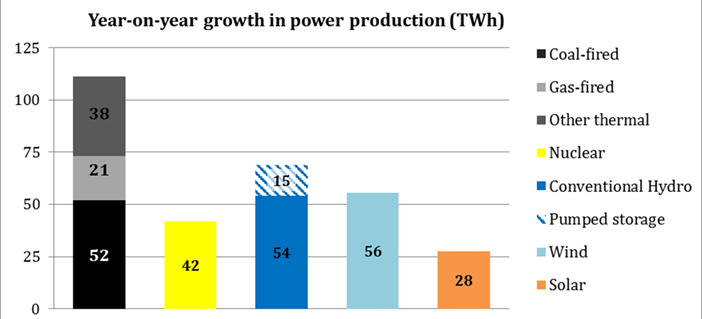Total electricity consumption in China rose to 5920 TWh last year. Renewables had a share of more than 25 percent, while year-on-year growth for thermal power generation was largest.

With an increase of 5 percent in 2016, Chinese electricity consumption of 5920 TWh can be mainly attributed to its industry. While households roughly consumed 800 TWh, secondary industry power consumption stood at 4211 TWh. The remainder is shared by primary and tertiary industries. The largest growth rates in power consumption with each more than 10 percent can however be attributed to tertiary industries as well as urban and rural households (Source: National Energy Administration).
Similarly than in the last years the average utilization of power generators declined, laying bare the overcapacities in the Chinese power sector. In 2016, thermal power full load hours went down by 200 hours to 4165, even lower than the lowest utilization level in decades 2015. Addition of new generating capacity amounted to 125 GW, ending 2016 with 1646 GW of installed capacity. With a growth of more than 80 percent, the capacity additions of solar power outstripped all other generators, except of coal. Figure 1 (own representation) depicts the installed power generating capacity in China along with the additions in 2016 in GW, as well as the year-on-year capacity additions in percent (Source: China Electricity Council).

Figure 1: Power generating capacity in GW (left axis) and the year-on-year growth in percent (right axis). Source: China Electricity Council
Clearly, the Chinese power system is still being dominated by coal, however the additions of solar (a total of 77 GW installed by the end of 2016) and wind power solar (a total of 149 GW installed by the end of 2016) in recent years led to an increasingly higher share of renewables in installed capacity.
Such an analysis however has to be complemented with the actual share in power generation from different sources. Not surprisingly, the huge additions of solar and wind capacity is also reflected in the increase of their power generation. In 2016, wind turbines generated 241 TWh of electricity, an increase of 30 percent compared to 2015 levels. Electricity generation from solar power grew by 72 percent with a cumulative generation of 66 TWh in 2016. The third-strongest growth can be attributed to nuclear power stations which generated 24 percent more electricity than last year and thus reaching 213 TWh. Even though with 5 percent, the growth rate of thermal capacity was not impressive, the year-on-year growth of coal and gas-fired generation in terms of electricity rivals that of renewables as can be inferred from figure 2 (Source: China Energy Portal).

Figure 2: Year-on-year growth in power production in TWh for different power generating technologies (source: China Energy Portal)
The largest growth in power generation can be attributed to thermal power plants such as coal, gas and oil, while the combined new electricity generation from hydro, wind and solar power amounted to 153 TWh in 2016. This new electricity generation by renewables in 2016 in China is almost on par with the electricity generation by all German renewables in 2016 with 186 TWh.
The incredible growth of renewables in China is certainly impressive. The challenges are however also daunting. Transforming a power system with 1000 GW of thermal generators, most of which are coalr-fired, will be a huge effort. In addition coal-fired power plants are arguably one of the most important sources for heating many of China’s northern mega-cities during the winter months. A district heating infrastructure – huge compared to the European one – has been build up and billions have been invested there as well (Source: ThinkChina). The reliance of the Chinese power sector on coal is and will therefore still be huge for years to come.
And even though renewables, especially hydro power plays a pivotal role in the generation mix, the replacement of coal by renewables, such as wind and PV, or low-emission technologies, such as nuclear or gas has yet to manifest itself. More than 65 percent of all electricity in 2016 has been generated by coal-fired power plants, as figure 3 aptly shows (Source: China Energy Portal).

Figure 3: China’s electricity mix in 2016 in TWh (source: China Energy Portal)
When compared to the 4 percent share of wind power or even only 1 percent by solar – despite of several years of strong growth in both technologies – the challenge becomes obvious. Most renewable generation is still hydro power, which at least might be a source of flexibility in the power system and thus could enable the integration of more fluctuating renewable generation from wind and PV.



